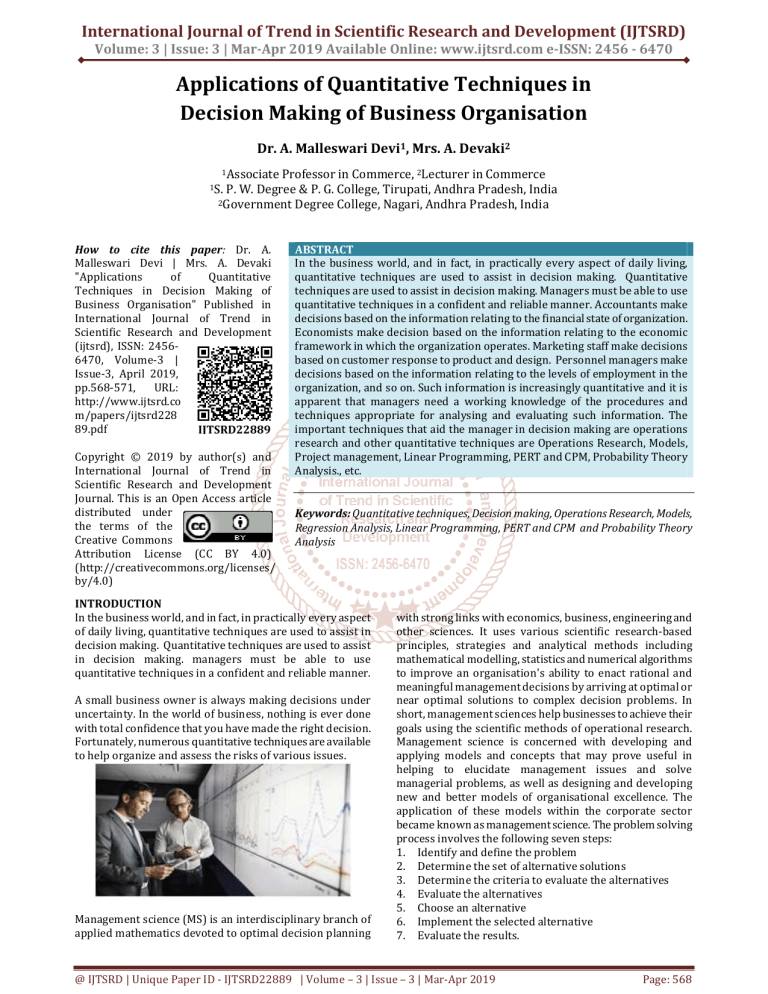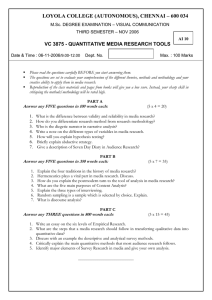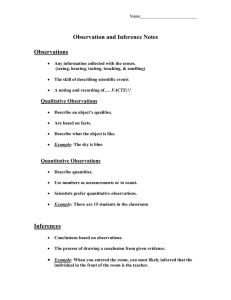
International Journal of Trend in Scientific Research and Development (IJTSRD)
Volume: 3 | Issue: 3 | Mar-Apr 2019 Available Online: www.ijtsrd.com e-ISSN: 2456 - 6470
Applications of Quantitative Techniques in
Decision Making of Business Organisation
Dr. A. Malleswari Devi1, Mrs. A. Devaki2
1Associate
Professor in Commerce, 2Lecturer in Commerce
1S. P. W. Degree & P. G. College, Tirupati, Andhra Pradesh, India
2Government Degree College, Nagari, Andhra Pradesh, India
How to cite this paper: Dr. A.
Malleswari Devi | Mrs. A. Devaki
"Applications
of
Quantitative
Techniques in Decision Making of
Business Organisation" Published in
International Journal of Trend in
Scientific Research and Development
(ijtsrd), ISSN: 24566470, Volume-3 |
Issue-3, April 2019,
pp.568-571,
URL:
http://www.ijtsrd.co
m/papers/ijtsrd228
89.pdf
IJTSRD22889
Copyright © 2019 by author(s) and
International Journal of Trend in
Scientific Research and Development
Journal. This is an Open Access article
distributed under
the terms of the
Creative Commons
Attribution License (CC BY 4.0)
(http://creativecommons.org/licenses/
by/4.0)
ABSTRACT
In the business world, and in fact, in practically every aspect of daily living,
quantitative techniques are used to assist in decision making. Quantitative
techniques are used to assist in decision making. Managers must be able to use
quantitative techniques in a confident and reliable manner. Accountants make
decisions based on the information relating to the financial state of organization.
Economists make decision based on the information relating to the economic
framework in which the organization operates. Marketing staff make decisions
based on customer response to product and design. Personnel managers make
decisions based on the information relating to the levels of employment in the
organization, and so on. Such information is increasingly quantitative and it is
apparent that managers need a working knowledge of the procedures and
techniques appropriate for analysing and evaluating such information. The
important techniques that aid the manager in decision making are operations
research and other quantitative techniques are Operations Research, Models,
Project management, Linear Programming, PERT and CPM, Probability Theory
Analysis., etc.
Keywords: Quantitative techniques, Decision making, Operations Research, Models,
Regression Analysis, Linear Programming, PERT and CPM and Probability Theory
Analysis
INTRODUCTION
In the business world, and in fact, in practically every aspect
of daily living, quantitative techniques are used to assist in
decision making. Quantitative techniques are used to assist
in decision making. managers must be able to use
quantitative techniques in a confident and reliable manner.
A small business owner is always making decisions under
uncertainty. In the world of business, nothing is ever done
with total confidence that you have made the right decision.
Fortunately, numerous quantitative techniques are available
to help organize and assess the risks of various issues.
Management science (MS) is an interdisciplinary branch of
applied mathematics devoted to optimal decision planning
with strong links with economics, business, engineering and
other sciences. It uses various scientific research-based
principles, strategies and analytical methods including
mathematical modelling, statistics and numerical algorithms
to improve an organisation's ability to enact rational and
meaningful management decisions by arriving at optimal or
near optimal solutions to complex decision problems. In
short, management sciences help businesses to achieve their
goals using the scientific methods of operational research.
Management science is concerned with developing and
applying models and concepts that may prove useful in
helping to elucidate management issues and solve
managerial problems, as well as designing and developing
new and better models of organisational excellence. The
application of these models within the corporate sector
became known as management science. The problem solving
process involves the following seven steps:
1. Identify and define the problem
2. Determine the set of alternative solutions
3. Determine the criteria to evaluate the alternatives
4. Evaluate the alternatives
5. Choose an alternative
6. Implement the selected alternative
7. Evaluate the results.
@ IJTSRD | Unique Paper ID - IJTSRD22889 | Volume – 3 | Issue – 3 | Mar-Apr 2019
Page: 568
International Journal of Trend in Scientific Research and Development (IJTSRD) @ www.ijtsrd.com eISSN: 2456-6470
Quantitative models give managers a better grasp of the
problems so that they can make the best decisions based on
the information available. Quantitative techniques are used
by managers in practically all aspects of a business.
A variety of quantitative methods of analysis are finding
more applications in business as managers learn how to use
these techniques to provide more insight into problems and
aid in daily decision-making.
Project Management
Quantitative methods have found wide applications in
project management. These techniques are used for
optimizing the allocation of manpower, machines, materials,
money and time. Projects are scheduled with quantitative
methods and synchronized with delivery of material and
workforce.
It is evident that quantitative techniques like mathematical
and statistical models which are describing a diverse array of
variables relationship, and they are designed to assist
managers with management problem-solving and decision
making. There are many of mathematical and statistical
techniques which can be used to help decision making by
managers of all types of business organization: large or
small, private sector, public sector, profit-oriented,
manufacturing, or service sector. Statistics is defined as the
process of collecting a sample, organizing, analysing and
interpreting data. The numeric values which represent the
characteristics analysed in this process are also referred to
as statistics.
Production Planning and Scheduling
Determining the size and location of new production
facilities is a complex issue. Quantitative techniques aid in
evaluating multiple proposals for costs, timing, location and
availability of transportation. Product mix and scheduling
get analysed to meet customer demands and maximize
profits.
Purchasing and Inventory
Predicting the amount of demand for a product is always
risky and uncertain. Quantitative techniques offer guidance
on how much raw material to purchase, levels of inventory
to keep and costs to ship and store finished products.
Marketing
Marketing campaigns get evaluated with large amounts of
data. Marketers apply quantitative methods to set budgets,
allocate media purchases, adjust product mix and adapt to
customers' preferences. Surveys produce data about
viewers' responses to advertisements. How many people
saw the ads, and how many purchased the products? Such
information is evaluated to get the return on investment in
an advertising campaign.
Finance
Financial managers rely heavily on quantitative techniques.
They evaluate investments with discounted cash flow
models and return on capital calculations. Products get
analysed for profit contribution and cost of production.
Workers are scrutinized for productivity standards and
hiring or firing to meet changing workloads.
Predicting cash flow is always a critical concern for
managers, and quantitative measurements help them to
predict cash surpluses and shortfalls. They use probabilities
and statistics to prepare annual profit plans.
Research and Development
Risking funds on research and development is always a bestguess scenario. The outcomes are never certain. So,
managers look to mathematical projections about the
probability of success and eventual profitability of products
to make investment decisions.
Agriculture
Operations research techniques have long been employed by
farmers. They utilize decision trees and make assumptions
about weather forecasts to decide which crops to plant. If
forecasters predict cold weather, is it more profitable to
plant corn or wheat? What happens if the weather is warm?
These are all probabilities that farmers use to plan their crop
rotations.
In an increasingly complex business environment managers
have to grapple with a problem and issues which range from
the relatively trivial to the strategic. In such an environment
the quantitative techniques have an important role. It is
obvious that life for any manager in any organization is
becoming increasingly difficult and complex.
Organizations find themselves operating in an increasingly
complex environment. Changes in government policy,
privatization, increasing involvement of the other country’s
union contribute to this complexity. At the same time,
organizations face increasing competition from both home
and abroad.
Because of the increasing complexity of the business
environment in which organizations have to function, the
information needs of a manager become more complex and
demanding also. The time available to a manager to asses,
analyse and react to a problem or opportunity is much
reduced. Managers and their supporting information
systems need to take fast, and hope-fully appropriate,
decisions. Finally, to add to the problems, the consequences
of taking wrong decisions become more serious and costly.
Entering the wrong markets, producing the wrong products
or providing inappropriate services will have major and big
consequences for organizations.
Managers must learn what the various tools are designed to
do and what the limits of their capabilities are. They must be
able to understand what staff specialists are attempting to
achieve by a particular analysis and to discuss the
appropriateness of alternative procedures sensibly (which
also requires the development of additional vocabulary).
They must fully understand the variables a model will and
will not consider and be able to evaluate whether the
relationships among the variables are sensible. Managers
cannot use an analytical tool wisely unless they fully
comprehend the underlying assumptions, what the analysis
achieves, what compromises the model makes with reality,
and how its conclusions are to be adapted to changing
circumstances and intangible considerations. All this process
requires a more thorough knowledge of operations than of
mathematics.
@ IJTSRD | Unique Paper ID - IJTSRD22889 | Volume – 3 | Issue – 3 | Mar-Apr 2019
Page: 569
International Journal of Trend in Scientific Research and Development (IJTSRD) @ www.ijtsrd.com eISSN: 2456-6470
The processing of real problems solving involves the
following steps:
1. Identification of corporate environment and uncertain
conditions
2. Existence of Independent Management Units
3. Integrated approach of actual situations
4. Implementation of Scientific Approach
Processing is primarily a matter of understanding that the
new reality is exogenously given, irreversible and one-way
pace. Open-minded cost/benefit analysis overcomes
hesitation and postponement and produces synergy effects
in due course, whereas the cost of inaction may be
insuperably higher than the action now. Critical role has the
timing for the problem of competitiveness in an uncertain
environment, incorporating the probability distributions of
the variables considered into the analysis. Decision-making
under uncertainty conditions is an analytic framework of
searching for:
1. Optimal strategies, as acts from all possible courses of
action, choices under control of the decision maker.
2. Various possible outcomes, states of nature or events to
be identified, beyond the control of the decision maker.
3. Determination of the pay-off function by describing
different combinations of acts and events and the
resulting consequences, the pay-off resulting from the ith strategy and the j-th event. A pay-off is a conditional
value - a conditional profit, loss or, may be, a conditional
cost. In building up apay-off matrix, the alternative
courses of action and the possible outcomes (events)
must be clearly determined.
The trade-offs among decisions under uncertainty, within
cost/benefit analysis, uses a number of basic principles, as
parts of the decision matrix:
1. The Laplace Principle (highest mean value or lowest
average cost), the Maxima or Minima Principle (choice
of the maximum from a set of strategies with minimum
pay-offs, adopted by pessimistic decision makers. While
such a principle has the logic of ensuring that decision
makers are in the best possible position if the worst
happens, the principle does obviously ignore the
potentially larger profit contributions that can be made
by other decisions);
2. The Maxima or Minima Principle (choice of the
maximum from strategies with the highest pay-offs,
adopted by optimistic decision makers. In general, for
this principle, decision makers determine the maximum
pay-off for each decision and then choose the largest of
these. This principle has the advantage of focusing on
the best possible outcome.);
3. The Hurwitz Principle (choice somewhere between the
extreme pessimism of the maxima and the extreme
optimism of the maxima principle);
4. The Savage Principle (choice of action that minimizes
the maximum opportunity losses from the so called
regret table);
5. The Maximum Likelihood Principle (considering first the
event that is most likely to occur and choice of the
course of action which has the maximum conditional
pay-off.);
6. The Bayesian Decision Rule (an extension of the optimal
strategy choice by calculation of the expected pay-offs
by using posterior probabilities, as additional
information about events is acquired);
7.
The Expectation Principle (the optimal choice
represents the strategy with the highest expected payoffs, calculated by multiplying the pay-off values with
their respective probabilities and adding up these
products).
The choice in decision making under risk conditions depends
on a series of objective and subjective factors, to mention a
few: information, enough knowledge of technology
possibilities, attitudes against risk, etc. Decision support
systems, analytical information technology and decision
trees are helpful in decision-making. The methods for
creating and analysing models, incorporating multiple
scenarios and more explicit treatment of uncertainty, involve
two overlapping disciplines: stochastic programming and a
relatively new field of strategy analysis called scenario
planning.
The risks of errors in estimates and predictive power of the
scientific methods are higher in phases of structural changes
to adjust in an irreversible new world. Scientific methods
aim at assisting the adjustment process that is a matter of
philosophy and conceptual framework e.g. the management
that serves the fundamental economic axiom, by eliminating
the misconceptions and co-ordinating effective mobilization
of total available resources.
Testing hypotheses leads to either confirmation or rejection
of a hypothesis. Theories, which cannot be tested, because,
they have no observable ramifications, do not qualify as
scientific theories. If the predictions are found to be in
disagreement with new experimental results, the theory may
be discarded as a description to reality, but it may continue
to be applicable within a limited range of measurable
parameter.
CONCLUSION
Quantitative analysis concentrates on the facts, data, or
quantitative aspects associated with problems. A managers
educational and technical knowledge of quantitative
procedures help to enhance the decision-making process.
The manager who is knowledgeable in quantitative decisionmaking procedures is in a much better position to compare
and evaluate the qualitative and quantitative sources of
information, or ultimately, to combine alternatives to make
the best possible decisions.
To an ever-increasing extent, modern management is
adopting and applying quantitative techniques to aid in the
process of decision making. The intelligent use of the
appropriate tools can reduce an otherwise highly complex
problem to one of manageable dimensions. Indeed, it is a fact
that the greatest impact of the quantitative approach will not
be in the area of problem solving, but will rather be on
problem formulation. It will radically alter the way managers
think about their problems-how they size them up, gain new
insights, relate them to other problems, communicate with
other people about them, and gather information for solving
them. Thus quantitative analysis could have a profound
effect on the "art" of management in taking decision
effectively and efficiently for any business organisation in
selecting the suitable alternative course of action or any
project alternative.
@ IJTSRD | Unique Paper ID - IJTSRD22889 | Volume – 3 | Issue – 3 | Mar-Apr 2019
Page: 570
International Journal of Trend in Scientific Research and Development (IJTSRD) @ www.ijtsrd.com eISSN: 2456-6470
REFERENCES
[1] AMET Journal of Management Jan – June 2011.
[2] Columbia University: Introduction to Operations
Research.
[3] Essay UK - http://www.essay.uk.com/free-essays/
management/role-in-quantitative-techniques-decisionmaking.php.
[4] Journal of Multidisciplinary Engineering Science &
Technology: Operational Research: A Study of Decision
Making Process.
[5] Sharma & Guptha, A text book of Quantitative
Techniques (2009), Kalyani Publishers.
[6] University of Waterloo: Examples of Operations
Research.
@ IJTSRD | Unique Paper ID - IJTSRD22889 | Volume – 3 | Issue – 3 | Mar-Apr 2019
Page: 571



